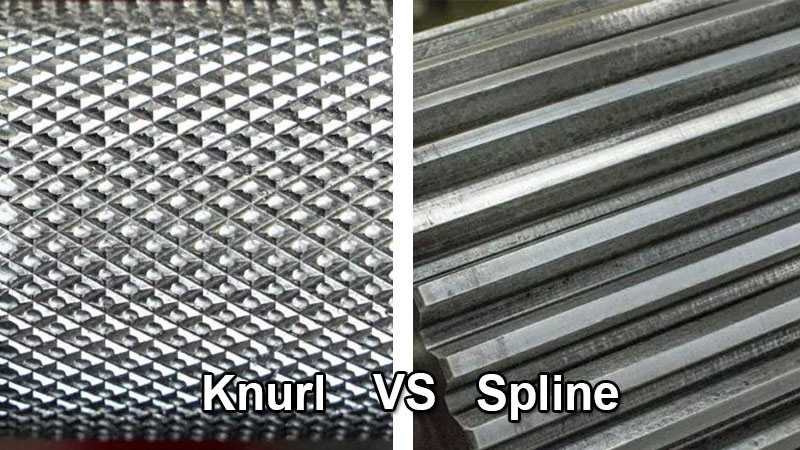In the world of manufacturing and machining, both knurling and splining are techniques used to create surface features that improve the functionality of mechanical parts. Though they might appear similar at first glance, knurls and splines serve distinct purposes and are used in different applications. Understanding the differences between them can help in selecting the right method for your specific engineering or machining requirements.
What is Knurling?
Knurling is a manufacturing process that creates a textured pattern on the surface of a part, typically on round objects such as handles, knobs, or fasteners. The process involves pressing or rolling a specially designed tool (knurling tool) against the surface of the material, which creates a series of ridges or grooves. These ridges increase friction, making it easier for users to grip or handle the part.
Types of Knurling Patterns:
Straight Knurling: Produces straight, parallel ridges along the circumference of a part. It is often used to create a better grip for hand-held tools.
Diamond Knurling: Forms a criss-cross or diamond-shaped pattern, offering improved grip over straight knurling. This is the most common knurling pattern for hand tools.
Helical Knurling: Consists of diagonal grooves that spiral around the part, typically used for decorative purposes.
Advantages of Knurling:
Improved Grip: The primary reason for knurling is to improve the user’s grip on a component, such as a tool handle, fastener, or knob.
Aesthetic Appeal: Knurling also adds a decorative finish to mechanical parts, enhancing the visual appeal of the product.
Functional Surface: Knurled surfaces are common in components where the user needs better control or handling, such as in sports equipment or instruments.
What is a Spline?
A spline, on the other hand, is a mechanical feature used to transmit torque between two rotating parts. Splines consist of a series of ridges, teeth, or grooves on a shaft that mesh with corresponding features on a mating part, such as a gear or coupling. This allows rotational power to be transmitted while maintaining precise alignment between components.
Types of Splines:
Involute Splines: The most common type, involute splines have curved teeth that resemble gear teeth and are widely used in automotive and industrial applications for transmitting torque.
Straight-Sided Splines: These splines feature straight-sided ridges and are often used in situations where a high degree of precision and axial alignment is required.
Helical Splines: Similar to involute splines, but with a helical or twisted shape, offering improved load distribution and better performance under high torque.
Advantages of Splines:
Precise Torque Transmission: Splines allow for the efficient transmission of rotational force between a shaft and its mating part, such as gears, pulleys, or couplings.
Axial Movement: Some spline designs allow for axial movement while still transmitting torque, making them ideal for certain mechanical applications like drive shafts or clutches.
Durability and Strength: Splines are used in applications where high loads, torque, and precision are required. They are commonly found in engines, transmissions, and other heavy-duty machinery.

Key Differences Between Knurls and Splines
Function:
Knurl: Primarily used for improving grip on a surface or for decorative purposes.
Spline: Designed for transmitting torque between rotating mechanical parts.
Appearance:
Knurl: Has a textured pattern, usually in straight, diamond, or helical forms. The pattern is generally shallow and meant for hand interaction.
Spline: Consists of deep ridges or teeth that mesh with corresponding features in another part, designed for high-load applications.
Application:
Knurl: Found in components like tool handles, knobs, screws, and any application where better grip is needed.
Spline: Used in mechanical systems that require precise torque transmission, such as automotive transmissions, drive shafts, and industrial machinery.
Machining Process:
Knurling: Created using a knurling tool, which presses or rolls the desired pattern into the surface of the material.
Splining: Manufactured by machining the grooves or ridges onto a shaft, typically using gear-cutting tools or broaching machines.
Load and Force:
Knurl: Not designed to withstand heavy loads or forces. It primarily serves as a tactile surface feature.
Spline: Capable of handling heavy loads and forces, transmitting significant torque between rotating parts.
Applications of Knurls and Splines
Knurling Applications:
Hand tools (such as wrenches and screwdrivers)
Machine knobs and handles
Fasteners (knurled bolts or screws)
Instrument dials
Sports equipment (such as golf clubs or bicycles)
Spline Applications:
Automotive drive shafts and gear systems
Aerospace components
Heavy machinery transmissions
Agricultural equipment
Robotics and industrial automation systems
Conclusion
While both knurls and splines involve the addition of ridges or grooves to mechanical components, they serve entirely different functions. Knurling is primarily about improving grip and appearance, whereas splining is all about precision and power transmission. Each has its unique place in the manufacturing and machining industries, and understanding when to use each can make a significant difference in the performance and reliability of a mechanical assembly.
By choosing the appropriate technique for your application—whether you need enhanced grip or efficient torque transmission—you can optimize the performance and usability of your product.



